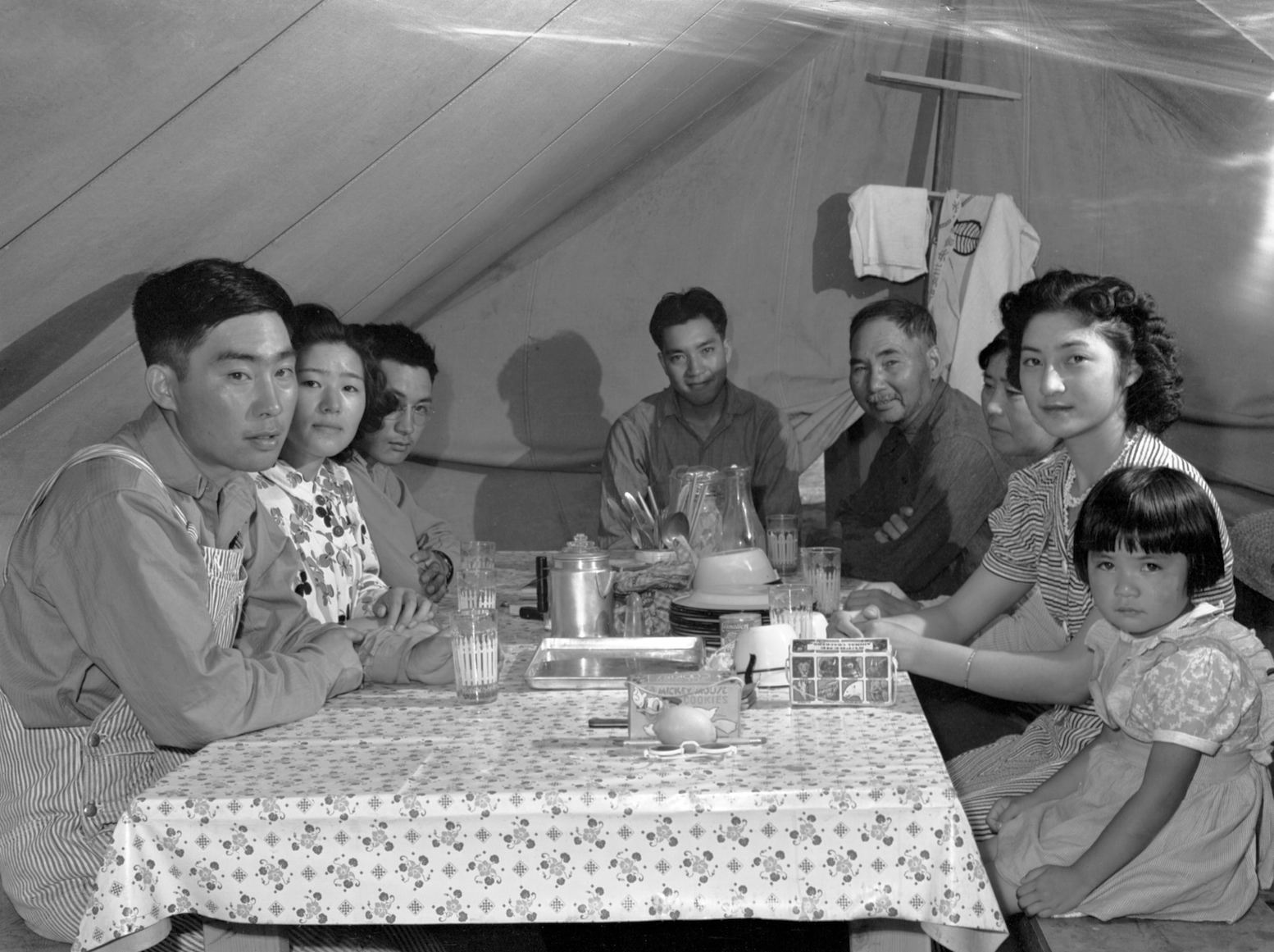
The Ouchida family at the Nyssa, Oregon farm labor camp, pictured clockwise from the lower left: Jack, Shizuko, Henry, Thomas, Kiuda, Shizuyo, Mary, and Rosie. Library of Congress, Prints & Photographs Division, FSA-OWI Collection, LC-USF34-073354-D.
PORTLAND, OR –December 1, 2016 – The Oregon Nikkei Legacy Center is proud to host Uprooted: Japanese American Farm Labor Camps During World War II. This nationally acclaimed traveling exhibit by the Oregon Cultural Heritage Commission will be on display from February 11th to June 19th. This is your only chance to see "Uprooted" here in Portland before it heads this summer to the Japanese American National Museum in Los Angeles.
During a period of extreme paranoia and heightened racism following the attack on Pearl Harbor by Japanese warplanes, President Franklin D. Roosevelt signed Executive Order 9066 on February 19, 1942. It authorized the forced removal and incarceration of more than 120,000 U.S. residents of Japanese ancestry (Nikkei)--nearly two-thirds U.S. citizens--from the West Coast to concentration camps. Between 1942 and 1944, some 33,000 individual contracts were issued for seasonal farm labor, with many incarcerated Japanese Americans working in the sugar beet industry. This exhibit introduces their story.
Uprooted features a selection of photographs from Russell Lee’s documentation of Japanese American farm labor camps near the towns of Nyssa, Oregon and Rupert, Shelley, and Twin Falls, Idaho. This is the first time many of these images have been exhibited. As a photographer for the Farm Security Administration (FSA), Lee captured nearly six hundred images of the Nikkei wartime experience. From 1935 to 1944, the FSA’s documentary photography program produced approximately 175,000 black-and-white film negatives and 1,600 color images.
Visitors will learn about Japanese American farm labor camps through Lee’s photographs, interpretative text panels, and a short documentary film featuring firsthand accounts about life in the camps. The exhibit’s website – www.uprootedexhibit.com - includes additional photographs, historic documents, video clips and transcripts from oral history interviews, and lesson plans.
This exhibit was supported by grants from the National Park Service, Japanese American Confinement Sites Preservation Program; the Idaho Humanities Council, a State-based Program of the National Endowment for the Humanities; the Fred W. Fields Fund of The Oregon Community Foundation; the Malheur County Cultural Trust; and the Rose E. Tucker Charitable Trust.
For more information on this project please contact the Oregon Cultural Heritage Commission. For questions regarding the JACS grant program, please contact Kara Miyagishima, Program Manager, Japanese American Confinement Sites Grant Program, NPS, at 303-969-2885.
OCHC MEDIA CONTACT:
David Milholland
OCHC President
503.285.8279
encanto@ochcom.org
uprootedexhibit@gmail.com
RELATED PROGRAMMING:
Lecture: “The Camp Without a Fence”: Nikkei Farm Laborers in Malheur County During World War II
Sunday, Feb. 28, 2016 | 2:00 PM
Epworth Methodist Church
1333 SE 28th Avenue, Portland, OR 97214
Please join us for this free lecture on our latest exhibit, Uprooted: Japanese American Farm Labor Camps during World War II, on view at the Oregon Nikkei Legacy Center. Morgen Young, consulting historian and project director of Uprooted, will provide insight on the Nikkei that volunteered to harvest sugar beets in Eastern Oregon and the photographer, Russell Lee, who was hired by the Farm Security Administration to document them. This lecture will also include special guests who will speak about their experience of being incarcerated at what became known as “The Camp Without a Fence.”
ABOUT THE OREGON NIKKEI ENDOWMENT:
The mission of the Oregon Nikkei Endowment is to preserve and honor the history and culture of Japanese Americans in the Pacific Northwest, to educate the public about the Japanese American experience during World War II, and to advocate for the protection of civil rights for all Americans. Our two projects include the Japanese American Historical Plaza in Waterfront Park, designed by landscape architect Robert Murase, and the Oregon Nikkei Legacy Center, a place to explore the culture and history of Japanese Americans, located in Portland’s historic Old Town neighborhood.
To see the exhibit on the web, visit here.
To visit the Oregon Nikkei Endowment and all of its exhibits, please visit here.